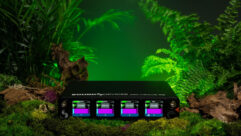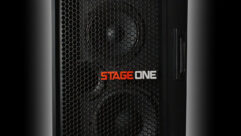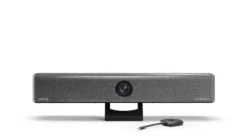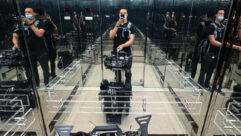
Wireless Sound Fires Up Park Pyrotechnics
Just outside of San Diego in the seaside town of Carlsbad, Legoland California is a different kind of theme park.
CHALLENGE: Extend sound reinforcement coverage to accompany a New Year’s Eve fireworks show to a viewing area unreachable with typical cable runs.
The satellite fireworks viewing area at Legoland California. The New Year’s Eve pyrotechnics at the park were choreographed against music via distributed audio, brought to viewers by an innovative wireless plan.
Credit: Courtesy of Legoland
SOLUTION: Build a custom wireless audio system using a self- produced DVD soundtrack and technologies borrowed from concert sound.
JUST OUTSIDE OF SAN DIEGO in the seaside town of Carlsbad, Legoland California is a different kind of theme park. Nestled within a landscape that serves as a life-size expression of blueprints you may well find in a Lego building brick manual, it’s also the site of an innovative wireless plan that brought distributed audio to a fireworks show seen and heard on New Year’s Eve for the last two years.
Choreographed against a soundtrack developed by Legoland show technician Paul Beach, the pyrotechnics painted the heavens in front of crowds gathered at a dedicated main stage as well as a satellite viewing area. Bringing the audio track to the main stage was no problem, but as Beach set forth to send his stereo feed to the other area, he met a number of physical obstacles, including trees and other vegetation. Using typical cable meant following a route through the environment that was highly circuitous in nature, winding every which way in a path and making the lengths of the runs untenable.
“The loudspeaker runs were just impossible for cable, mainly because of the labyrinth of routing it would have required to get through the park,” he recalls. “However, I had successfully experimented with wireless audio on the main stage, so left with no other real option for the entrance, I expanded upon that same idea and chart an audio path to the satellite viewing area directly by going completely wireless all the way.”
TESTING 1, 2, 3…
Despite the presence of RF signals emitted from a multitude of wireless devices at Legoland, none have proven to be a problem to the operation of Paul Beach’s cordless PA, this thanks to careful mapping of a comprehensive, clash-free RF blueprint.
“We’ve never had any RF interference problems here at all, “ says Beach. “The real challenge in building this rig centered around RF power. We had to travel a distance of about 1,600 feet to make it work, which is essentially the length of the entire park. “
Once typical loudspeaker cabling was ruled out as a possibility for the system, Beach set about testing various wireless devices that would fulfill his needs. A/B trials among potential candidates eventually revealed that by redefining the role of Shure’s PSM700 in-ear monitoring system, the plan would work.
“Running in mono, the PSM700 transmitter’s RF output power is rated at 100 mW,” says Beach. “That’s considerably more than the other systems we tried, plus we gained full stereo capabilities.”
Relying on far more than spec sheets to reach his conclusions, Beach conducted trial-by-fire testing that was straightforward and demanding. After successfully running the system through the gauntlet with a basic 1/8th wave antenna on the transmitter and a shorty antenna on the receiver, he upped the ante by jumping in a golf cart and driving throughout the park with a paddle antenna-equipped receiver. A paddle antenna was used on the transmitting end this time around as well, with source signals coming from an iPod.
“We had the power to reach every area of the park,” says Beach of his subsequent discoveries. “And we didn’t even have to face the antenna at the receiving end.”
Use of the rig recently has also included a configuration employing four stand-mounted Electro-Voice Sx200 loudspeakers fueled by a single QSC PowerLight 1.8 amplifier operating in bridged mono and receiving signals from a wireless-fed Mackie 1202 mixer.
“From here, it’s really just a short jump to take this idea to a level of providing distributed audio throughout the park’s entire 40 acres,” adds Beach. “We have already determined it will work while cruising around in our golf cart tests. I envision a park-wide system using smaller loudspeakers that can be expanded as needed. The flexibility of what we could do is limited only by our imagination.”
Beach’s wireless design was enabled with the assistance of Jon Bart of Quiet Voice Audio from Fallbrook, Calif., and Mike Cromer of Huntington Beach, Calif.-based Audio Geer. Bart and Cromer encouraged Beach to develop his wireless idea for some time before his decision to approve the project, and were brought in to help fulfill gear list requirements. Within Beach’s vision, the system would be straightforward and bulletproof, requiring little more in the way of hardware than a music source, compact mixing capabilities, loudspeakers, and some wireless transmission and retrieval scheme.
A musician who played bass with the 1960s vocal group The Mamas & the Papas and other chart-topping bands of the era, Beach still performs professionally. No stranger to in-ear personal stage monitors as a result, he was familiar with the Shure PSM700 system Bart and Cromer suggested he transform to meet his wireless needs.
With portability in mind, the first time Beach did the show, he brought in a pair of two-way, Mackie SRM450 loudspeakers and placed them on Ultimate Support stands to serve his intended coverage area. He chose a 16-channel Mackie 1604-VLX Pro Series mixer to manage mixing chores. He made the wireless operation completely weatherproof by mounting the Shure PSM700 in-ear system receiver inside of a Pelican dry box that was outfitted with a rubber lining and rubber seal, then attaching it to one of the self-powered loudspeakers. Using Shure paddle antennas at both the receiver and transmitter ends, his goal was to send sound more than 1,000 feet across a section of park inhabited with a fair share of other potentially interfering RF signals, as well as trees, buildings, and related wireless hazards. While typical cable runs for the loudspeakers would have topped as much as 1,200 feet, Beach lucked out in terms of AC sources for his self-powered loudspeakers, which were located a mere 15 feet away from each cabinet next to some planters in the landscape.
Normally found in use as a beltpack device coupled with any of a number of different Shure earpieces, the PSM700 receiver in the Legoland fireworks sound system took to its new home in the Pelican enclosure, which was bought as an empty project box by Beach at a local Fry’s Electronics store. Two flush-mounted XLR connectors were added to the box. The receiver’s antenna connector also was made easily accessible, and connects to a 25-foot long cable leading to a Shure paddle antenna mounted atop an eight-foot tall boom stand.
“The PSM700 receiver’s output leaves the Pelican box traveling in stereo on standard 1/8-inch mic cables to the Mackie self-powered loudspeakers,” says Beach. “Everything is balanced. From the receiver, which is held in place with velcro inside the Pelican box, an 8-inch TRS cable terminates with soldered connections at the flush-mounted XLR connectors. I adapted BNC connectors for use on both ends of the cable running between the receiver, and an antenna input flush-mounted between the two XLR connectors within the Pelican box. A standard Shure cable runs from the Pelican box out to the Shure paddle antenna. When I first tested the system with Mike Cromer, we just had the shorty antenna on the receiver like you’d use onstage. On the transmitter, we had an 1/8th wave antenna. The system worked with those, so we figured performance would only get better with paddles at both ends. The first time I used the system for a show, I set the receiver’s volume at about 75 percent.”
FOR MORE INFORMATION
Electro Voice
www.electrovoice.com
FireOne
www.fireone.com
Shure Inc.
www.shure.com
Pelican Products USA
www.pelicanproducts.us
Mackie
www.mackie.com
Denon
www.denon.com
Like any show, this one came with a budget for audio and the fireworks. The soundtrack worked with the latter accordingly, timing itself to the explosions. The nine-minute show featured a score given to Beach, who in turn edited and prepped it for delivery across the park via his custom wireless rig.
Initially, Beach thought of committing the sound-track to a Tascam DA-88 to gain the benefit of its 16-bit digital capabilities, but then changed his mind when he considered what may happen once the recorder was exposed to the humidity and salt air of Legoland’s oceanside location. Housed behind the main stage in a rack with the Mackie mixer, which uses one of its aux feeds to send source material to the PSM700 transmitter, a Denon DVD-2910 DVD player was chosen instead, with Beach using its 5.1 features on the front left and right channels, and SMPTE time code for his lights and FSK wireless time code for the pyro team on others. Not a widely known time code within the pro audio/AV world, FSK from pyrotechnics manufacturer FireOne is a favorite among pyrotechnicians.
“I was pleasantly surprised when we first tried out the system,” says Beach. “I was expecting to hear a severe amount of companding, and figured my signal would be squashed, but that wasn’t the case at all. Running the volume at about 75 percent, I had plenty of headroom, and it was plenty loud. We had no problem holding the crowd. If you think about it, what we created was a giant set of earbuds. For the 400-500 people who gathered at the spot to see the show, the sound was ideal.”
Based upon the success of the design, Beach is already dreaming of other wireless schemes he can implement at Legoland. “Just wait ‘til I go fully digital,” he says. “That’s when the real fireworks will begin.”










